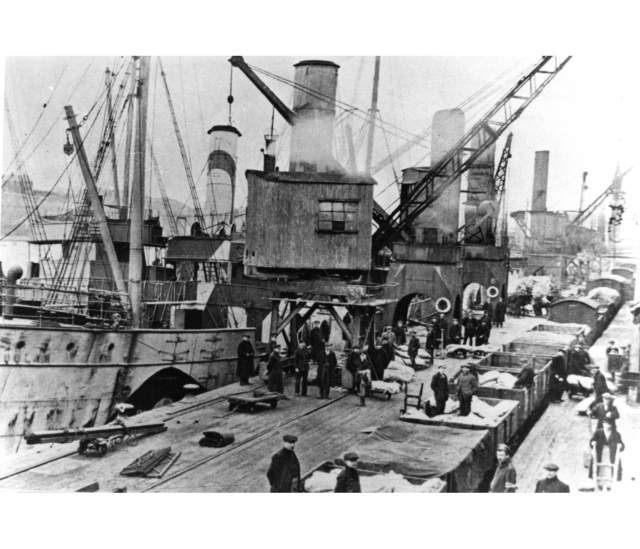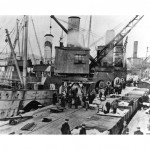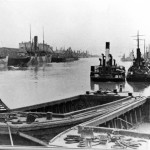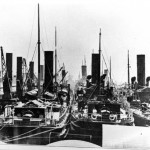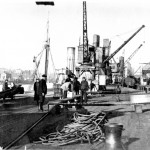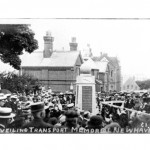Read this article to learn about the Newhaven Port during the First World War.
Before the outbreak of the First World War, Newhaven was a key point in travel between Britain and Europe. Newhaven was the departure port for the railway and steamship link from London to Dieppe.
Passengers could ride the train down from London before boarding one of the twice daily steamships that would cross the channel in just under three hours. As a result, it was a key port for tourism and travel.
At the outbreak of war in 1914, the government quickly took control of Newhaven Port and it was closed to the public; all passenger services to France were suspended.
Because of its location on the East Sussex coast, Newhaven was ideally placed to deliver supplies across the sea. However, in the early months of the war, the requirements of the military and the desires of private shipping companies often collided.
During 1914 and the early part of 1915, Britain was operating under a system often referred to as ‘Business as usual.’ Whilst the country may have been at war, the government did not want the conflict to prevent the normal running of the country. They hoped that the war would be swiftly won without disrupting trade and commerce.
Instead of ‘Business as usual,’ the new controls at Newhaven Port provided an example of what would be known as ‘Total War‘ where the government could control any public or private business or property to support the war effort.
Following the decision to take control of Newhaven’s harbour, steamships were changed to transport of supplies across the channel. These supplies included ammunition, clothing, food, and horses. The return journeys from France would often include hospital ships returning wounded men to Britain.
By October 1915, 45 transport vessels were involved in taking supplies across the channel. Around 6,000 tonnes of supplies were being delivered to France by these ships every day and this number would rise as the war continued. In order to maintain the constant levels of shipping, additional workers were sought to load ships at the quayside. Newly employed Chinese Labourers were used at Newhaven Harbour after 1917. By February 1918, 100 women were employed to work the docks. Within a month this number had risen to over 400.
Because of the ammunition supplies passing through Newhaven, the dock was under the control of the military. Newhaven Fort was constantly guarded by soldiers throughout to protect the port and surrounding coastline. The greatest fear regarding Newhaven, however, was the effect an attack on the town might cause.
Alongside the guards at Newhaven Fort, eight boy scouts kept watch from the clifftops from 6am until 10pm every day and also acted as messengers. Patrolling above them were seaplanes and also airships from Polegate. These searched for German U-Boats that might be hiding in the channel and also kept watch for any incoming German planes and bombers.
Commander P.B. Garrett from the Naval Transports Office was keen to emphasise the huge danger of an attack on the port from either the air or by torpedo:
I would like to point out that it appears extremely essential that the ammunition Transports should never, when loaded, be allowed to remain in this harbour, as in the event of an air raid and a bomb being dropped on to any of these vessels the destruction of the whole of the quays and most of the town, would be the inevitable result. In consequence I am using the vessels that can leave at almost any hour of tide and larger than those now used could not be used to advantage.
By the end of the war, Newhaven Port had played a huge role in supplying the army abroad. 866,021 train trucks had delivered supplies to the quayside at Newhaven. These supplies had been delivered to France by 165 ships making a total of 8,778 voyages. Over 6 million tonnes of supplies including 2.6 million tonnes of ammunition were delivered to France during these supply trips.
However, this effort was not without a cost. The names of 99 people who lost their lives whilst delivering supplies to France were inscribed on the Newhaven Transport Memorial following its unveiling in 1920.
Questions to ask your students
1) What was Newhaven Port used for before the war?
2) Why was Newhaven Port important during the war?
3) How many tons of supplies left Newhaven Port during the war?
Images
- Newhaven Harbour – Courtesy of Newhaven Museum
- Transports loading and drifters WW1 Newhaven – Courtesy of Newhaven Museum
- Transports loading in Newhaven during WW1 – Courtesy of Newhaven Museum
- Transports loading in Newhaven during WW1 – Courtesy of Newhaven Museum
- Unveiling Newhaven transport memorial at junction of Meeching and D’Acre Roads after 1918
Click here to download a copy of this resource: First World War – Newhaven Port – teachers

